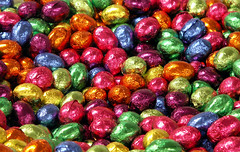- in Green Home , Have Fun by Alexis Rodrigo
How To “Green Up” Easter
Does the thought of swaths of plastic Easter grass and dozens of plastic eggs make the environmentalist in you cringe?
Here are some ways to make Easter green without festooning the planet with fake grass!
1. Give your children a decorative cloth bag with a set of child’s garden tools, seeds, or other gardening supplies instead of an Easter basket. A bucket of sand box toys or “nature kit” bag are other alternatives.
2. Choose eco-friendly materials for Easter baskets, such as hemp or jute. Or purchase hand-made, fair trade certified baskets that you can find other uses for after Easter (how about toy storage?).
3. Make your own Easter basket from materials around the house, such as hand-decorated bags, totes, wastebaskets, laundry baskets, etc.
4. Fill the baskets with biodegradable material that can be composted, such as natural straw, hay, moss, or simply grass from outside. You can also shred up the Sunday funnies or colorful scrap paper. Shred some of those colorful catalogues and magazines that come in the mail.
5. Make your own treats for the basket – bake special cookies, cupcakes, and candies.
6. Re-use what you have. Do you already have plastic eggs from last year, from well-intentioned friends, or from your children’s school projects? Glue them onto a round frame to make a wreath. If you already have plastic grass, use it as a base for a centerpiece or creative springtime scene.
7. Decorate using scrap paper and junk mail – cut out bunny shapes and string them onto colorful yarn, or cut out Easter shapes into a chain.
8. For your Easter feast, serve eco-friendly meats such as organic ham and free-range turkey. Serve vegetables from local farmers or from the wild – cooked dandelion greens are an early spring tradition that goes back many years.
9. Dye eggs using natural dyes -mix a tablespoon of white vinegar per cup of boiling water and add onion skins (yellow), red cabbage (light purple), shredded raw beets (deep red), spinach (light green), coffee grounds or tea (brown), etc.
10. Use free-range eggs or, better yet, obtain your eggs from a local farmer or urban chicken-keeper. If the eggs are brown, you can use eco-friendly paints on them instead of dyes.
11. Fill your children’s Easter baskets with enduring wooden toys (such as puzzles, trains, or cars), pocket-sized board games, a deck of cards, dominoes, etc. Take your child’s personality into consideration rather than just giving the “usual” stuffed bunny and plastic trinkets. Then you can build a basket theme around your child’s interests.
All of these ideas will help reduce waste this Easter season.
If you liked this post, submit your email address below to get new posts by email:

